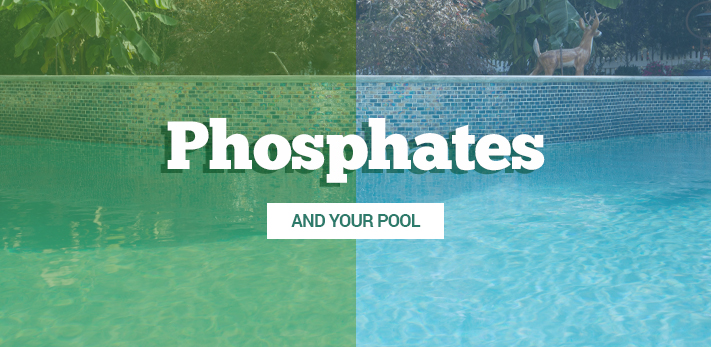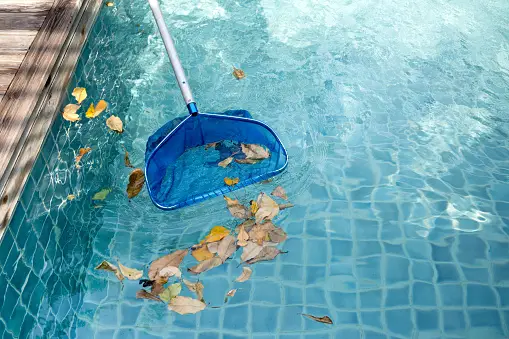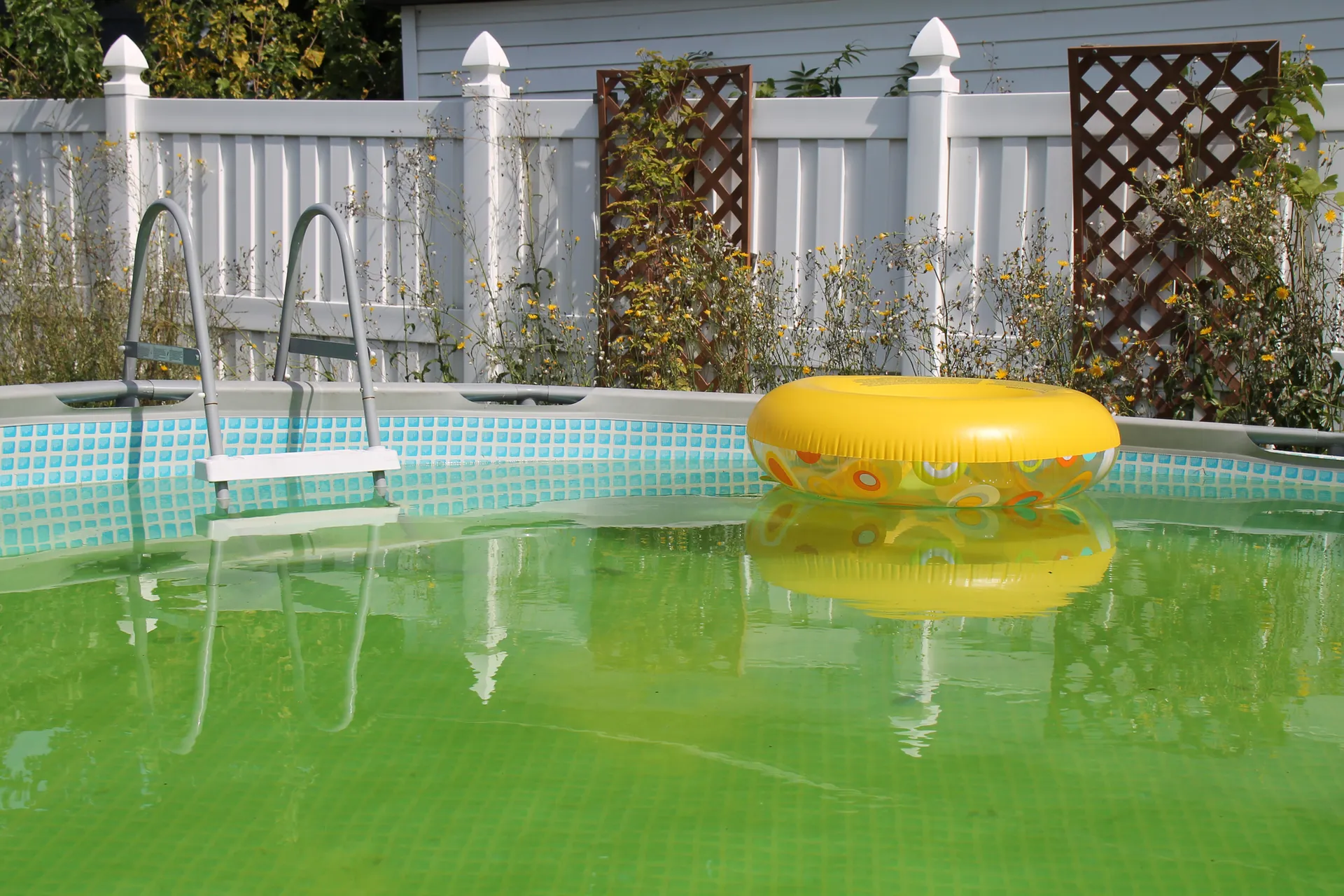The newest miracle chemical this year for your swimming pool is the Phosphate Eliminator which removes Phosphates from your pool that some say are the main source of food for Algae. Do you need to remove phosphates from my swimming pool water?
- Normally, No, Phosphates don’t have to be removed but high levels can lead to algae
- Keep pool chemistry balanced
- Regular backwash & filter
- Minimize organic sources (fertilizer, leaves)
- Test pool occasionally to monitor phosphate
- Remove some pool H2O if phosphate exceeds levels
- Try Phosphate Remover for control
Your Pool is a Chemically controlled process that if kept under certain conditions won’t have algae competing for any phosphates that are naturally found in your pool. Phosphates enter the pool water through the air, wind, and people using it and are considered one of many algae food sources found in water.
Introduction:
Sparkling, crystal-clear waters are the hallmark of any inviting swimming pool, but underlying in pool water according to some pool owners could be a pesky problem: phosphates. These invisible troublemakers are often at the center of the pool care debate, stirring questions about their impact and the necessity of their removal. In this article, we’ll take a good look into the phosphate issue, unraveling the facts from myths and providing clarity on whether your pool truly needs a phosphate purge. Join us as we unveil the truth behind phosphates and their place in your pool paradise.
Do You Need to Remove Phosphates From a Pool
Removing phosphates from a pool is not typically necessary for routine pool maintenance, but high phosphate levels can contribute to algae growth. Algae thrive in environments with excess nutrients like phosphates, so controlling phosphate levels can help prevent algae outbreaks.
There are a few methods to reduce phosphate levels in a pool:
- Use a Phosphate Remover: Chemical products are designed to bind with phosphates in the water, making them easier to filter out. These products are available at pool supply stores and typically contain lanthanum compounds.
- Backwashing and Filtration: Regularly backwashing the pool filter can help remove phosphates, as can using a filter specifically designed to trap fine particles and contaminants.
- Maintain Proper Water Chemistry: Keeping the pool’s pH, alkalinity, and chlorine levels balanced can help prevent algae growth and reduce the need for phosphate removal.
- Reducing External Sources: Phosphates can enter the pool from various sources such as fertilizers, debris, and rainwater. Minimizing these sources can help control phosphate levels.
It’s essential to test the pool water regularly to monitor phosphate levels and take appropriate action if they become too high. However, if your pool is well-maintained and you don’t experience frequent algae problems, you may not need to worry about removing phosphates unless they reach excessive levels.
If you are worried about phosphate levels being too high in your swimming pool then there are more natural ways of dealing with it. Removing a few inches of pool water now and again can control pool phosphate levels and algae growth should be a non-issue at least due to high Phosphate levels.
- If you have a multi-port valve on your pool filter, shut off your pump and turn the valve to Recirculate or Recycle. This will mix the floc around without filtering the water and is the best way to mix the contents of your pool.
- Add the recommended dosage of liquid or powder flocculant to your pool. Remember there are approximately 7.5 gallons of water in 1 square foot of pool water.
- Circulate your water for 3 hours, or as long as it takes for your pool’s pump to turn the pool over. Then shut off your pump and let it sit overnight. The floc will bind to the algae and Phosphate, then settle on the pool bottom floor.
- In the Morning-Turn the multi-port valve Setting to Waste so dirty water doesn’t blast back into your pool through your return lines. Hook up your backwash hose to the Backwash/Waste port. Direct your waste water appropriately.
- Vacuum your pool. Work slowly to make sure you get all the thick sediment off the bottom. If the water gets too cloudy, you may need to stop and allow the particles to settle again before continuing to vacuum.
- Add water while you’re vacuuming because you’ll be removing quite a lot
- Shock immediately after vacuuming to eliminate any remaining algae. You may also want to brush the pool
- Brush the sides and floor of the pool before shocking.
- Run your pool filter until the water clears
Is High Pool Phosphate Levels Harmful
High phosphate levels in a pool are not directly harmful to humans, but they can contribute to problems with the pool water quality. Phosphates act as a nutrient source for algae, and when present in high concentrations, they can promote the growth of algae in the pool. Algae growth can lead to water discoloration, reduced water clarity, and the need for more frequent maintenance.

Controlling phosphate levels is important for pool maintenance to prevent algae issues. While phosphates themselves may not harm swimmers, the algae that can thrive in high phosphate environments might create an unpleasant swimming experience.
To address high phosphate levels, pool owners often use phosphate-removing products or follow specific procedures to reduce and control phosphates in the water. Regular testing and maintenance of water chemistry can help manage phosphate levels and keep the pool water clear and safe for use.
Still, Phosphate in pool water is Safe, it is Very Safe. Found naturally in nature. High Phosphate levels are not toxic to people or animals unless they are present at very high levels. Digestive problems could occur from extremely high levels of phosphate. Phosphates are added to drinking water in some states in the country to prevent corrosion caused by copper and lead in pipes.
Phosphate is one of the key elements on earth that is necessary for plant life growth.
They are still allowed to be added to cleaning products and some dishwasher Detergents. The problem comes when an overload of nutrients in streams and rivers like the nutrient, phosphorus which can help grow plant life such as Algae way too fast.
Because of this, Oxygen that is dissolved in water would be sucked out of the stream or river producing an anaerobic environment that would snowball killing fish and plant life that will decompose and will add more nutrients and chemicals to the water, and so on causing a snowball effect. That’s a Biological Problem Not a Pool Problem!
In a swimming pool, the water is chlorinated and if chlorinated properly there won’t be an algae problem, to begin with. Phosphates maintain their perfect oxidation levels all by themselves, so they don’t react with chlorine at all.
For the most part, phosphates will coexist with pool chemicals and only matter at very high levels. Most pools lose water through evaporation and usage. If you add fresh water to your pool you are diluting any phosphate levels that may have built up.
How do you know if there are phosphates in your pool? Just use the cheap test strips that come with pool kits and you’ll get some kind of idea. However, some studies show that they only affect pool algae growth at extremely high levels of 1,000 ppb (parts per billion) or more.
So, monitor the phosphate levels at the start of the season but don’t get crazy about it or concerned when phosphate is present because it always will be present. it’s a natural element here on Earth and is added to drinking water. There always will be a trace of it in water.
Here’s a video I made quite a while ago about Phosphates in Pools (sorry about the quality I was learning how to do it)
What is the Best Swimming Pool Return Jets Position?
At the Deepest End of the pool
turn the Return Jets (eyeballs) located on the pool walls angled down toward the bottom of the pool at a 45° angle
In the Shallow End of the pool
Turn return Jets clockwise to about 8 o’clock at a 45° angle so the return water to the pool is mixing in a .……………………………………………………. Read more
Does Phosphate Create Algae Growth in Pool Water
Yes, phosphates can contribute to algae growth in pool water. Algae require nutrients to grow, and phosphates act as a nutrient source that supports algae proliferation. When phosphates are present in pool water at elevated levels, they provide an ideal environment for algae to thrive.

Pool owners often use phosphate-removing products or follow specific procedures to reduce the concentration of phosphates in the water. More importantly, maintaining proper water chemistry, regular cleaning, and using algaecides can help control algae growth and keep the pool water clear and clean. Regular testing for phosphate levels is a good practice to monitor and address any potential issues before they lead to algae problems.
If you are losing sleep over this Pool store-developed dilemma then you should do a few things to offset your chances of Phosphates naturally in pool water turning your pool green.
- Skim your pool with a pool skimmer will drastically improve your odds of less Phosphate in your pool and you should be skimming your pool.
- Brush the sides of the wall and the bottom of your pool– This should be done a couple of times a week
- Clean out the Skimmer Boxes where twigs and leaves can collect in your pool causing algae and phosphate
- Keep your pool covered when not in use. (that ain’t gonna happen)
- Control your Pool’s Alkalinity, PH and chlorine Residual-Use a reliable kit with fresh reagents and test for phosphate levels at the beginning and towards the end of the summer. That’s all you need to do. Read this article here at MyWaterEarth& Sky called Testing Pool Water.
- Use an Algae Prohibitor or Add fresh water to your pool weekly-twice per/month.
- Fresh pool water is a great inexpensive proven product, especially in those “Dog Days Of Summer” to keep phosphate down
Swimming pool maintenance is more hump work than technical ability. Some problems if not most in pools can be fixed without taking out your credit card. Most times, your Pool just needs some good old fashion Hump Work rather than adding more pool chemicals.
Pool Stores advise high levels of phosphates promote algae growth and they have the phosphate remover treatment to add to your pool that will solve the problem. High phosphates in pool water may not be a control problem. Pool care involves chlorine and chlorine prevents algae growth in swimming pools.
As long as I have been caring for my in-ground pool, I have never witnessed a high Phosphate result on my testing equipment. At least where it causes mischief such as turning the swimming pool water green from algae.
Although I knew coming from Water and Wastewater Treatment that higher levels of Phosphates and phosphorus types have the potential to feed and encourage algae growth phosphates are not toxic or harmful in your swimming pools. Phosphates are necessary for the environment in the life cycle not in your pool chemistry but many things don’t belong in your swimming pool.
What are the Red Cross Temperature Guidelines for Swimming Pools?
According to the Red Cross
- Pool temperatures for infants-90°-93°F
- pre-school-aged children-90°-93°F
- Seniors should be-90°-93°F
- Pools used for physical therapy must also be at a higher temperature, ideally around 86°F.
- For exercise or competitive swimming-77°-82°F
- As a general rule, keep it about 77°-84°F …………………………………………………………………… Read more
What Causes High Phosphate Levels in a Swimming Pool
Phosphates are naturally occurring compounds that can enter your pool from several sources. Compounds made of phosphorus and oxygen will create high levels of phosphates and promote algae growth if the pool water isn’t balanced and disinfected with regular pool care high phosphate shouldn’t get out of hand.

Phosphates have the potential to feed and encourage algae growth in your swimming pool phosphates don’t do anything to affect the water quality in your pool.
High phosphate levels in a swimming pool can be attributed to various factors, and they are often the result of external contaminants or the breakdown of other pool chemicals. Here are some common causes of elevated phosphate levels in a pool:
- Lawn and Plant Fertilizers: Runoff from nearby lawns and gardens treated with fertilizers can introduce phosphates into the pool water.
- Rainwater: Rain can wash organic debris, soil, and fertilizers into the pool, contributing to increased phosphate levels.
- Landscaping and Debris: Leaves, grass, and other organic debris that fall into the pool can release phosphates as they decompose.
- Tap Water: The water used to fill or top off the pool might contain phosphates, especially in areas where the local water supply has elevated phosphate levels.
- Personal Care Products: Swimmers entering the pool with sunscreen, hair products, or other personal care items may introduce phosphates.
- Chemical Imbalances: Issues with other pool chemicals, such as imbalances in pH, alkalinity, or calcium hardness, can contribute to the breakdown of compounds, leading to increased phosphate levels.
To manage and control phosphate levels, pool owners can use phosphate-removing products, regularly clean the pool and its surroundings, and ensure proper maintenance of water chemistry. Regular testing is crucial to monitor phosphate levels and address any issues promptly.
Run a phosphate test for phosphate in your swimming pool at the beginning of the season especially if you keep the same pool water from the previous year. If it’s high waste some pool water through the pool filter then add fresh water to the pool. That is most likely all you need to do.
*Phosphate levels will move up and down throughout the season but should not be a worry. Instead, keep well-balanced pool chemistry for complete control phosphates don’t do anything to affect the water quality in your pool
Conclusion:
In conclusion, the presence of phosphates in your swimming pool could potentially feed algae growth, thus complicating pool maintenance. However, it’s important to remember that phosphates alone will not cause algae blooms without the presence of other necessary nutrients. Before resorting to phosphate removers, ensure balanced pool chemistry and proper sanitation. Consult a pool professional to assess the need for phosphate removal in your pool. Ultimately, understanding and managing phosphates is just one piece of the vast puzzle of pool care, but it doesn’t have to be a source of stress when handled wisely.
Have a great summer season!
What Type of Chlorine Works best to Control your Pool?
The Best Chlorine for you to use daily in your pool & for Shocking:
Granular
Contains over 70% of the active ingredient (AC) Available in Chlorine
Fast Dissolving
Contain Stabilizer like Cyanuric Acid
Tablets
99% Active Ingredient-Trichloro-S-Triazinetrione (Trichlor)
Slow-dissolving
Contains Stabilizer …………………………………………………………………………………………………….. Read more

References:
University of Minnesota- Phosphurous Cycle
FAQ’s
Q: Can phosphates directly harm swimmers?
A: Phosphates themselves do not harm swimmers directly, but their indirect effects, such as promoting algae blooms, can overwork sanitizing chemicals like chlorine and influence overall pool chemistry, affecting swimmer comfort and safety.
Q: Is it necessary to use phosphate remover in my pool?
A: While phosphate levels alone might not always lead to algae issues if pool chemistry is properly balanced, when phosphate levels are significantly high, using a phosphate remover becomes a necessary step to control algae growth and maintain clear water. It’s advisable to test phosphate levels and use a remover if required.
Q: Do I need to constantly use phosphate remover?
A: No, constant use of phosphate remover isn’t always necessary if your pool’s chemical balance is well maintained and phosphate levels are moderate. However, in areas with persistent high phosphate levels, regular use of a remover can help manage levels and maintain water clarity.
Q: Does the removal of phosphates guarantee an algae-free pool?
A: While the removal of phosphates can reduce algae growth, it doesn’t guarantee an algae-free pool. Regular maintenance, including chemical balancing and cleaning, is also essential. Phosphate removal is beneficial but should be part of a comprehensive pool maintenance strategy.
Q: How do I determine if I need to remove phosphates from my pool?
A: Regular testing of your pool’s water for phosphates will indicate whether levels are high and if removal is necessary. If tests confirm elevated phosphate levels and you’re experiencing issues like algae growth, using a phosphate remover would be a sensible approach.
